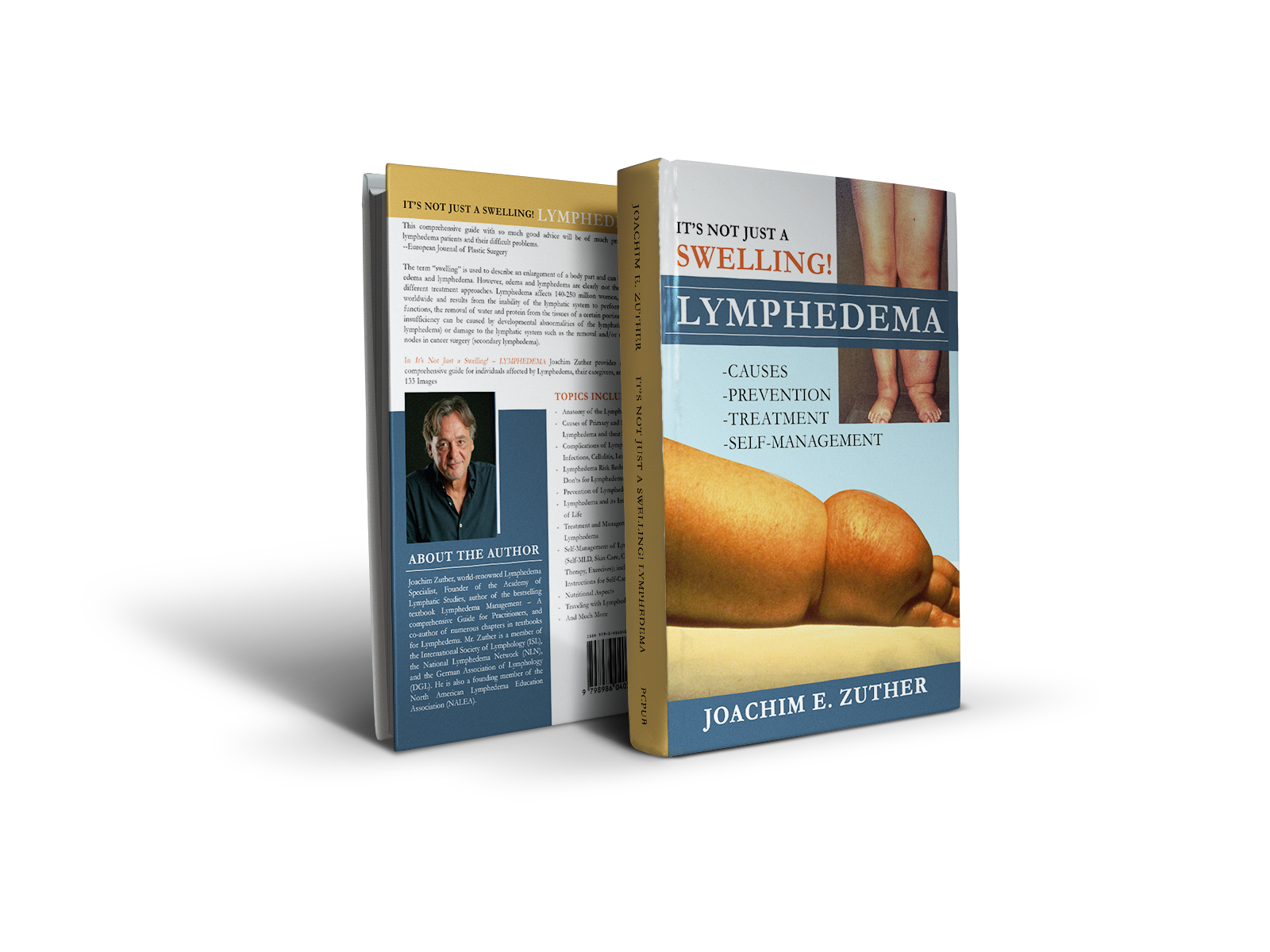New Book for Patients and Caregivers 
In It’s Not Just a Swelling! – LYMPHEDEMA Joachim Zuther provides an up-to-date and comprehensive guide for specifically geared towards individuals affected by Lymphedema, their caregivers, and family members. 133 Images. Paperback and Kindle version
Topics include:
- Self-Management of Lymphedema (Self-MLD, Skin Care, Compression Therapy, Exercises); includes Instructions for Self-Care with images
- Nutritional Aspects
- Lymphedema Risk Reduction, Do’s and Don’ts for Lymphedema
- Complications of Lymphedema, such as Infections, Cellulitis, Leakage
- Lymphedema and its Impact on Quality of Life
- Traveling with Lymphedema
- Prevention of Lymphedema
- Treatment and Management of Lymphedema
- Causes of Primary and Secondary Lymphedema and their Stages
- Anatomy of the Lymphatic System
- And Much More
Click Here to Buy
The Author 
Joachim Zuther, Lymphedema Specialist. Read more |
By Joachim Zuther, on July 1st, 2022
Dear Friends in the Lymphedema Community!
I am very happy to report that the publication “It’s Not Just a Swelling! Lymphedema” is a big success; many of you who already read and use it have reported back to me indicating that the contents are very useful and a great help in dealing with . . . → Read More: Lymphedema Book for Patients
By Joachim Zuther, on May 31st, 2025
Certain activities may trigger the onset of lymphedema or may exacerbate the symptoms of existing lymphedema. Individuals affected by lymphedema and those at risk for developing it (everyone who has undergone lymph node excision and/or radiation treatments) should observe the following precautions. The “Dos” and “Don’ts” below are based on decades of experience . . . → Read More: Dos and Don’ts for Lymphedema of the Leg
By Joachim Zuther, on May 1st, 2025
Certain activities may trigger the onset of lymphedema or may exacerbate the symptoms of existing lymphedema. Individuals affected by primary or secondary lymphedema and those at risk for developing it (everyone who has undergone lymph node excision and/or radiation treatments) should observe the following precautions. The “Dos” and “Don’ts” below are based on . . . → Read More: Dos and Don’ts for Lymphedema of the Arm
By Joachim Zuther, on April 5th, 2025
Early diagnosis and intervention of lymphedema are crucial for optimal treatment results. Whether lymphedema is caused by developmental abnormalities (primary lymphedema), or surgery/radiation to the lymphatic system (secondary lymphedema), the possible long-term physical and psycho-social burden resulting from untreated or mistreated lymphedema can be serious.
The classification of lymphedema into primary and secondary has . . . → Read More: Obesity and Lymphedema
By Joachim Zuther, on March 10th, 2025
I have been involved in lymphedema care for the past thirty years, having received my training in Germany, where Complete Decongestive Therapy (CDT) for the treatment and management of lymphedema has been well established since the 1970s.
After moving to the U.S. in the early 1990s I learned that in this country adequate lymphedema . . . → Read More: The Evolution of Lymphedema Care in the United States
By Joachim Zuther, on February 1st, 2025
The use of intermittent pneumatic compression (IPC) in the treatment of lymphedema continues to be a topic of discussion and their use is neither accepted as a replacement nor a component of complete decongestive therapy (CDT), the accepted gold standard of lymphedema treatment. However, studies suggest that there is a potential place for . . . → Read More: Intermittent Pneumatic Compression Devices in the Treatment and Management of Lymphedema
By Joachim Zuther, on January 1st, 2025
A discussion on the role of compression garments and compression classes in the treatment and management of lymphedema . . . → Read More: The Role of Compression Garments in the Treatment of Lymphedema
By Joachim Zuther, on December 4th, 2024
Unlike the heart in the blood circulatory system, the lymphatic system does not have an active pump to propel lymphatic fluid back into the bloodstream. Effective lymph flow depends on sufficient muscle and joint activity, especially if the functionality of the lymphatic system is compromised.
Abdominal (diaphragmatic) breathing exercises are a . . . → Read More: The Benefits of Abdominal Breathing Exercises in the Management of Lymphedema
By Joachim Zuther, on October 28th, 2024
The term “swelling” is used to describe an enlargement of a body part and can be used to describe edema, as well as lymphedema. While the initial causes for the formation of the swelling are different, both involve the accumulation of fluid in the soft tissues of the skin due to some form . . . → Read More: How Lymphatic Insufficiencies Result in Edema or Lymphedema
By Joachim Zuther, on September 19th, 2024
It is important to understand that the elastic fibers in the tissues affected by lymphedema are damaged. These fibers lose their elasticity and tend to harden, which is particularly the case in untreated lymphedema present over a long period of time and progressed stages of lymphedema.
Although the swelling in lymphedema may be reduced . . . → Read More: The Science behind Compression Therapy in Lymphedema Management
By Joachim Zuther, on August 12th, 2024
Chronic primary or secondary lymphedema is a progressive condition, which cannot simply be described as an accumulation of protein-rich fluid as a result of inadequate lymphatic drainage. It is a chronic degenerative and inflammatory process affecting the soft tissues, skin, lymph vessels and lymph nodes, often resulting in severe and disabling swelling. It . . . → Read More: Bioimpedance Spectroscopy (BIS) – an Effective Tool for the Assessment of Lymphedema
|
Support the Lymphedema Blog This blog is supported by donations. Click to donate today.

Disclaimer The information on this web site is not intended to give medical advice and does not necessarily reflect the opinions of any physicians, nor is it guaranteed to be correct and complete. You should not rely on any information in this web site without seeking the advice of a physician or certified healthcare provider.
|


 Joachim Zuther, Lymphedema Specialist.
Joachim Zuther, Lymphedema Specialist. 
